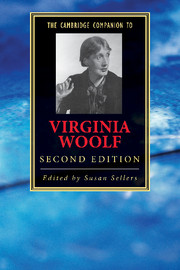Book contents
- Frontmatter
- 1 Bloomsbury
- 2 Virginia Woolf’s early novels: Finding a voice
- 3 From Mrs Dalloway to The Waves: New elegy and lyric experimentalism
- 4 The novels of the 1930s and the impact of history
- 5 Virginia Woolf’s essays
- 6 Virginia Woolf, modernism and modernity
- 7 The socio-political vision of the novels
- 8 Woolf’s feminism and feminism’s Woolf
- 9 Virginia Woolf and sexuality
- 10 Virginia Woolf, Empire and race
- 11 Virginia Woolf and visual culture
- 12 Virginia Woolf and the public sphere
- Guide to further reading
- Index
11 - Virginia Woolf and visual culture
Published online by Cambridge University Press: 28 July 2010
- Frontmatter
- 1 Bloomsbury
- 2 Virginia Woolf’s early novels: Finding a voice
- 3 From Mrs Dalloway to The Waves: New elegy and lyric experimentalism
- 4 The novels of the 1930s and the impact of history
- 5 Virginia Woolf’s essays
- 6 Virginia Woolf, modernism and modernity
- 7 The socio-political vision of the novels
- 8 Woolf’s feminism and feminism’s Woolf
- 9 Virginia Woolf and sexuality
- 10 Virginia Woolf, Empire and race
- 11 Virginia Woolf and visual culture
- 12 Virginia Woolf and the public sphere
- Guide to further reading
- Index
Summary
People spilt off the pavement. There were women with shopping bags. Children ran out . . . nothing could be seen whole or read from start to finish. What was seen begun - like two friends starting to meet each other across the street - was never seen ended . . . Orlando heaved a sigh of relief, lit a cigarette.
Virginia Woolf's Orlando, like many of her works, is shaped by her knowledge of, and fascination with, visual cultures. Orlando, Flush and Three Guineas all contain photographs and other images. All of Woolf's writings have visual tropes, and many draw on contemporary debates about the arts, and popular visual cultures. Here Orlando adopts the optical point of view of a classic Hollywood camera, with medium rather than long shots, and ends on a close-up frame. David Trotter argues in Cinema and Modernism that, as well as analogies between literary and cinematic forms in Woolf's writing, what cinema more radically taught her was how to portray 'constitutive absence', for example Mrs Ramsay's absence in To the Lighthouse, and the ways in which 'movement (in particular casual movement) defines space'.
Overview
But cinema was only one of a number of visual cultures that Woolf enjoyed and which impact on her work. In addition, she was an active photographer from childhood, she herself was photographed for Vogue, and references to advertising and architecture abound in her writings. Woolf wrote the first British essay on avant-garde cinema. Visual artefacts of all kinds, ranging from Omega Workshop crafts to the Hogarth Press book designs, were part of her visual landscape and she had a wide circle of artist friends and family. Woolf’s responses to modern visual cultures are what make her a modernist writer.
- Type
- Chapter
- Information
- The Cambridge Companion to Virginia Woolf , pp. 214 - 230Publisher: Cambridge University PressPrint publication year: 2010
- 2
- Cited by

